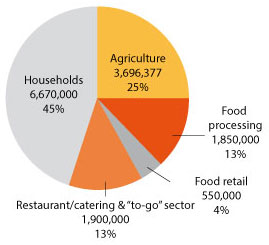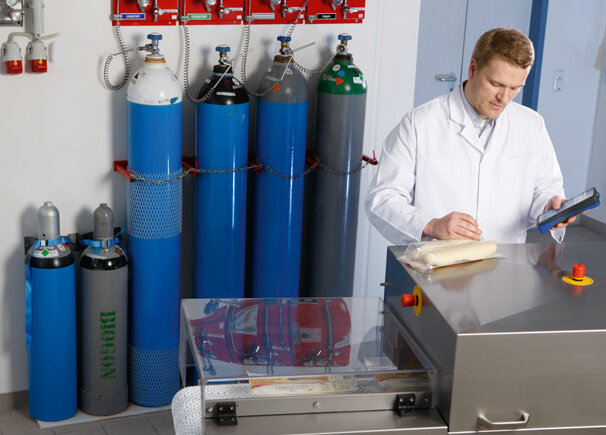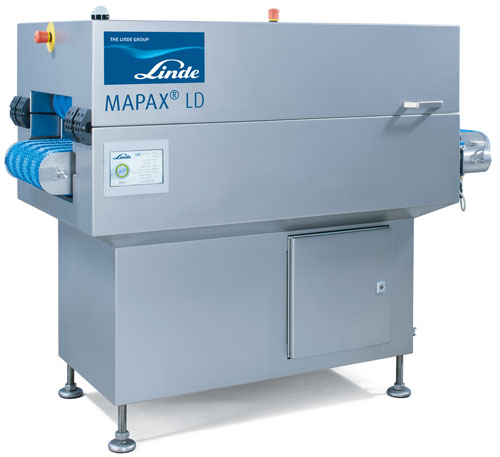Leak testing of modified atmosphere packages
DLG Expert report 6-2016
Author:
- Saskia Huber, Global Marketing Manager Secondary Industries, Application Technology, Commercial Management, Linde AG, Linde Gases Division, Carl-von-Linde-Str. 25, 85716 Unterschleissheim saskia.huber@linde.com, www.linde-gas.de. In cooperation with the DLG Food Technology Committee
Contact:
- Dr.-Ing. Annette Schmelzle, DLG Competence Center Food, A.Schmelzle@DLG.org
In cooperation with the DLG Food Technology Committee.
Modified Atmosphere Packaging (MAP) is an extremely effective way of preserving food and extending its shelf-life. However, MAP is only effective if the actual package itself is intact, making leak testing an essential process step in any end-toend packaging concept. Once produce has been packaged in a modifi ed atmosphere, manufacturers should ensure that only packages in perfect condition leave the production line. A number of methods are available for leak testing. These range from random underwater sampling through visual inline testing to gas-based leak detection solutions. For food producers, reliability and effi ciency are the key success factors when it comes to selecting the most suitable method.
Every year, nearly 15 million metric tonnes of food are wasted in Germany alone. This was the fi nding of a study conducted by the University of Stuttgart and funded by the German Federal Ministry for Food and Agriculture (see chart).1
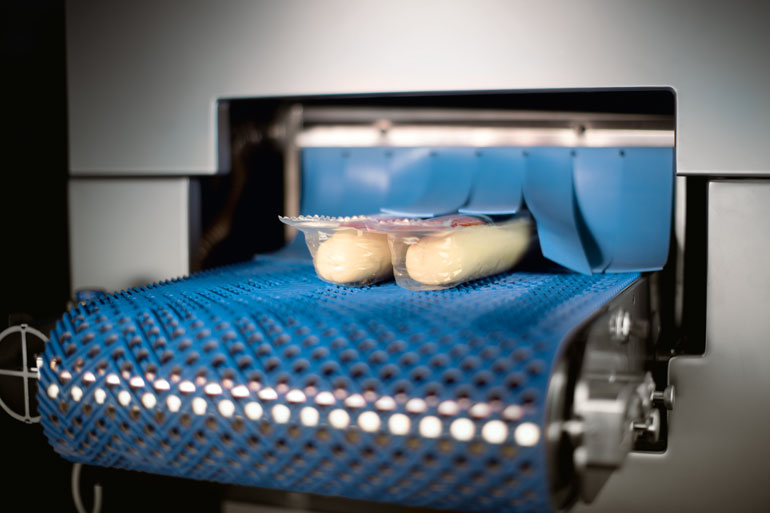
Food is wasted along the entire value chain. According to the study, the main source of this waste is private households, accounting for 6.67 million metric tonnes. This corresponds to an annual average of 81.6 kg per citizen. 1.9 million metric tonnes of food waste are attributable to large-scale users, 1.85 million metric tonnes to industry and 0.55 million metric tonnes to the food retail trade. The reasons for this waste vary depending on the sector. In industry, which is responsible for 13 percent of food waste, produce is discarded, for instance, due to faults in the production process. The retail trade, for example, disposes of stock that has passed its sell-by date and of surplus stock resulting from fl uctuations in shopping behaviour, which is diffi cult to predict. Similarly, private consumers bin food primarily because it has passed its best-before date, but also because they undervalue foodstuffs, plan poorly and do not store it appropriately. In a Forsa survey, 84 percent of consumers interviewed cited expiry of the best-before date or spoilage as reasons for throwing food away.2
The natural way to preserve food
Widely recognised and used around the world, MAP enables food producers to meet retailer and consumer expectations for fresh, appetising produce with a long shelf-life. MAP often supplements other techniques such as high-pressure and microwave methods or oxygen absorption. The gases carbon dioxide (CO2), nitrogen (N2), oxygen (O2) and argon (Ar) are generally used in modifi ed atmospheres. Depending on the food in question, these gases are mixed in different ratios to retain the taste, structure and appearance of the packaged goods. In addition to tailored gas mixtures, the packaging fi lm also plays a key role in maintaining freshness. It serves as a barrier against water vapour, UV light and gases. Leaks as a result of a faulty seal or defective material, for instance, have a negative impact on quality and must be detected in production as early as possible. If the packaging is damaged, the food generally spoils before the best-before date, exposing the producer to the risk of complaints and damage to their image or even causing health hazards for end consumers.
Sampling versus inline testing
In leak testing, a distinction should generally be made between random sampling and integrated testing. Testing random samples to identify leaks is a low-cost method, but limited to individual packages instead of an entire batch. If a significant number of units are sampled, reasonably reliable conclusions can be drawn about the status of the batch overall.
Other methods, however, enable food producers to test each package in a batch for leaks. These are referred to as inline solutions and vary according to the underlying technology. Some methods are suited only to certain types of packaging so they may, for instance, be limited to rigid or flexible materials. Other applications test for leaks at batch level. These batch tests may be suitable for reasons of space, for instance. However, similar to sampling, batch testing can mean that an entire batch may have to be discarded or repackaged due to a single faulty package. The most cost-efficient and effective approach lies in a flexible leak detection system with the ability to test each package and identify individual faulty packages without compromising production throughput. This could ensure that leak testing does not become a bottleneck in the production line. The most common methods of sampling and inline testing methods are presented in the following.
Overview of systems – sampling
Water bath
The simplest sample testing method for leaks is a water bath. If a package is submerged, rising gas bubbles indicate leaks. Solutions based on this method have been developed for the food industry. The test works as follows: The package to be tested is placed in a vacuum chamber filled with water and the air above the water is removed. As a result of the difference in pressure, the packaging becomes inflated. If there is a leak, air bubbles rise visibly from submerged package. The advantage is that the leaky point can be precisely located. The wet package and its contents are then waste. In view of the simple operation and low investment costs, this type of leak testing is widespread.
Differential pressure method
Another way of sampling packages is through the differential pressure method. Here the packaging to be tested is placed in a chamber, from which the air is then automatically removed. If the pressure in the sample packaging drops because of a leak, the pressure will differ from the reference value. The results of the test are available in a few seconds and can be documented. No special test gas is needed for this system. The inert modified atmosphere or air present in the packaging is sufficient to conduct the test. Unlike the water bath method, this test is non-destructive so that the tested units can be returned to the production line. It is possible to integrate systems such as these into the production line in order to automate sample testing. As this test takes a relatively long time (several seconds per package) to run, this solution is suitable for low-speed testing scenarios.
Gas-based methods
Gas-based methods test the integrity of packaged produce by analysing the modified atmosphere or by adding a trace gas to the modified atmosphere. Compared with the water bath test, gas-based leak detection is a fast, objective and non-destructive way to test for leaks. CO2 has proven particularly suitable here, as it is often a component of the modified atmosphere. With this method, the package is placed in a test chamber, from which the air is subsequently removed. If there is a leak, CO2 escapes from the package due to the difference in pressure between the test chamber and the package being tested. This difference is detected within seconds by highly sensitive sensors. Consequently, even the tiniest of leaks can be identified, while the package remains intact.
This test can also be set up to detect the noble gas helium from the modified atmosphere. This is an ideal trace gas due to its inert properties. It does not react with other substances and thus does not affect the packaged foodstuff. In addition, helium is only present in the atmosphere in very low concentrations (5 ppm). So helium leak tests deliver extremely precise values. This test uses mass spectrometry to detect helium that has escaped from the test object into the vacuum chamber. The result is given as a total leakage rate. One or more leaks can be pinpointed using a hand probe. Thanks to the very low helium concentration in the atmosphere and a precisely definable concentration in the test object, helium offers superior testing results compared with other gases. This noble gas is, however, quite costly as it is extremely rare and in rising demand across a wide variety of industrial applications.
Overview of systems – inline testing
Optical inspection systems
Originally developed for a range of tasks extending from labelling, lettering and barcode checks to content level and cleanliness tests, optical inspection systems are growing in popularity for leak testing. Sophisticated cameras and evaluation software are enabling ever-smaller and more robust solutions that are particularly suited to quality testing of foods. Given the strict hygiene regulations that apply in the food industry, non-contact checking by means of imaging systems is obviously ideal. At the heart of these systems is an image analysis software solution tailored to the application in question. The most suitable hardware components – such as lights, cameras and lenses – are selected in close consultation with the machine manufacturer, who integrates these into the feed and positioning equipment. Extremely high-performance vision systems are used. Analysis software and interfaces are integrated into the high-resolution monochrome cameras, so that the test can be integrated into the packaging lines with relative ease.
With this system, the packaged produce is guided past a high-speed camera directly after the packaging process. The actual condition is compared with an image of the target condition. If the result is unsatisfactory, the faulty product is then automatically removed. This method is extremely effective at detecting labelling or sealing faults. However, it cannot always clearly distinguish between a purely optical fault and an actual leak and – in the event of doubt – rejects all packages that do not appear to comply with the target condition.
Measuring the package height
The high speeds required in food production also lend themselves to a technology that records leaks by measuring the package height. The package height is first measured under a predefined pressure. The package is then subjected to the maximum pressure possible without harming it and then measured again. If there is any difference in height between the first and second measurement, the package is deemed to be leaky and is rejected. All values can be adjusted individually for each product. The definition of “tight” and “leaky” may prove to be difficult here, however, as variations in the packaging height occur naturally within the packaging process and not all variations classify as a fault. Solutions using this technology can handle up to 150 packages per minute. This method is suitable for flexible, easily deformable packages such as flow-wrap packages (tube bags, film packages) and plastic containers (trays, PET bottles).
Measuring carbon dioxide in a vacuum
Another way of subjecting modified atmosphere packages to an inline leak test involves using the inert gas CO2 as a trace gas, which can then be detected in a vacuum. The test is conducted by passing the packages containing CO2 through a detection chamber after the packaging process. A vacuum is created, causing a pressure difference between the test object and the chamber. If a package has a leak, the CO2 escapes and is detected by a sensitive CO2 sensor. This is a reliable way to identify leaks. The creation of a vacuum and the venting of the detection chamber after each measuring cycle take time, however. This limits this method to high-volume production lines.
To ensure full coverage, this test is therefore generally applied to an entire batch or box. As a result, if even just one package is faulty, all packages in the batch or box have to be checked individually again, repackaged or possibly discarded.
Latest technologies and further developments
The latest gas-based technologies are capable of detecting even the tiniest leaks without having to create a vacuum – which is a time-consuming process. CO2 or hydrogen (H2) can also be used as the trace gas. As CO2 is present in the surrounding air, conventional methods require a vacuum in order to detect the release of CO2. Infrared laser technology is an interesting and innovative alternative way to detect CO2. The modified atmosphere must contain at least 10% CO2 in order for this to work. These compact detection units can be installed directly on the production line. Slight pressure is exerted on the package by means of a roller and this causes gas to be released if there is a leak. This gas is analysed using a laser and the CO2 content is determined. If the CO2 content is elevated, the package is immediately removed by means of a sliding arm. Up to 180 packages per minute can be tested in this way.
Alternatively, CO2 can be replaced with H2 or helium as the trace gas. Only a small quantity of these trace gases (up to a maximum of four percent) is added to the modified atmosphere. Due to the small size of its molecules and the resulting high diffusion capacity, H2 is an ideal gas for leak detection. Slight mechanical pressure on the packaging allows the hydrogen to escape from the packaging along with the modified atmosphere. If a package is not intact, the H2 leak is detected by a sensitive sensor. It is not necessary to produce a vacuum, as hydrogen is only present in the surrounding air in very low concentrations. If a leak is detected, the sensor triggers an optical alarm. The packaging in question is removed directly from the production line, either by a compressed air stream or a sliding arm. Depending on the size of the package, it is possible to test up to 120 packages per minute.
Looking ahead – leak tests growing in importance
Both retailers and consumers expect food produce to be in perfect condition. As such, leak tests are set to play an increasingly important role, also as a tool to avoid the risk of compensation claims. Although leak testing is not yet generally considered a Hazard Analysis and Critical Control Point (HACCP), it is looking increasingly likely that it will become a part of HACCP self-regulation requirements. The HACCP concept is defined in EU Regulation 852/2004 on the hygiene of foodstuffs, Article 5.3 It aims to help identify, evaluate and manage food safety risks that arise during production. It outlines the following HACCP principles and obligations:
• Analyse all possible hazards for foodstuffs throughout the entire food business
• Identify all process steps that are potentially hazardous
• Select and define critical points for food hygiene
• Define appropriate measures to control and monitor the process steps
• Regularly control the effectiveness of the HACCP system
Modern leak test systems support documentation of the test results, enabling food producers to document their duty of care in the packaging process.
Conclusion
Consumers and retailers have extremely high expectations when it comes to food freshness and quality. The food industry can meet these demands for freshness by packaging food in modified atmospheres. The final leak test is a crucial step to preserve product quality right up to the best-before date and minimise the risk of claims for compensation or damages. Hundred-percent testing of all packages ensures the greatest possible security for producers, the retail trade and consumers. Various systems that support one hundred-percent testing are available on the market. These differ widely depending on the underlying technology and the application. Today, however, a number of manufacturers offer modern solutions that not only allow reliable testing, but can also support the rapid throughput required in today’s food processing plants.
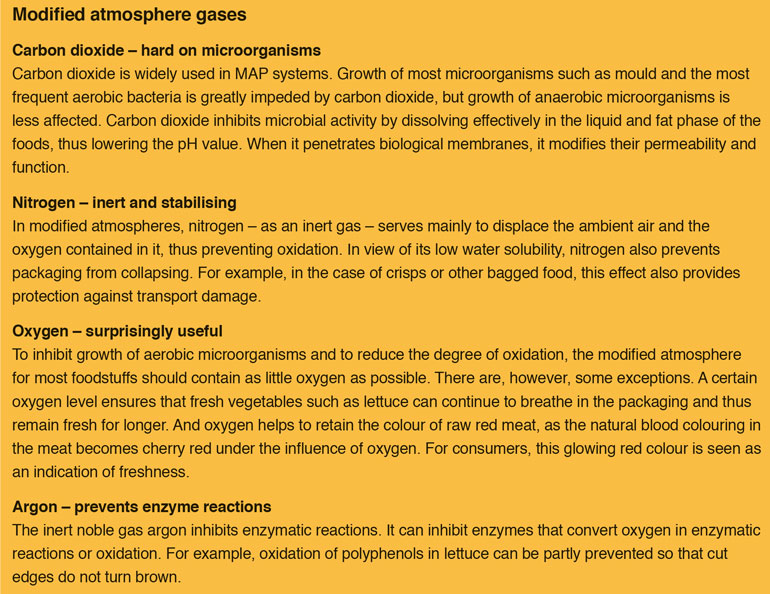
3 HACCP – Self-regulation and documentation requirements for the hygiene of foodstuffs in industry, available in German at www.suedlicher oberrhein.ihk.de/recht/Wirtschaftsrecht/Gewerberecht/Lebensmittelhygiene/HACCP/1333638#titleInText0 (retrieved on 30 June 2016)
Contact:
Dr.-Ing. Annette Schmelzle, DLG Competence Center Food, A.Schmelzle@DLG.org
In cooperation with the DLG Food Technology Committee.


